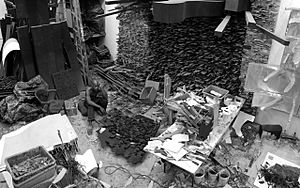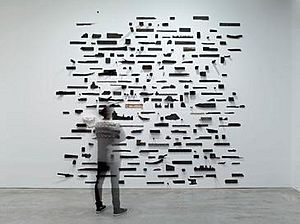Leonardo Drew facts for kids
Quick facts for kids
Leonardo Drew
|
|
|---|---|

Drew in his studio
|
|
| Born | 1961 (age 63–64) Tallahassee, Florida, U.S.
|
| Known for | Sculptures |
Leonardo Drew is a famous artist from Brooklyn, New York. He makes amazing sculptures using natural things like wood and metal. He often changes these materials by making them look old or rusted. His art helps us think about big ideas like fairness and how life keeps going in cycles.
Contents
Early Life and Inspiration
Leonardo Drew was born in Tallahassee, Florida. He grew up in Bridgeport, Connecticut, in an area where he could see the city's dump from his home. As a child, he often explored the dump. He would find old, discarded items and turn them into new creations. This experience taught him about how things change and are reborn.
Drew once said that the dump felt like a place where things began, ended, and then began again. Even though he now uses new materials in his studio, his early experiences with discarded items still influence his art. He explores ideas about life, death, and new beginnings.
Becoming an Artist
Leonardo Drew started his art career very young. He first showed his work to the public when he was just 13 years old. His early drawings caught the eye of people from famous comic book companies like DC Comics and Marvel Comics.
Later, Drew discovered a type of art called abstraction. This inspired him to focus on fine arts. He studied at Parsons School of Design in New York. He then earned his degree from Cooper Union in 1985.
Where You Can See His Art
Leonardo Drew's sculptures are displayed in many important art museums. Some of these include the Metropolitan Museum of Art in New York and The Tate in the United Kingdom. His work is also in the Solomon R. Guggenheim Museum and the Hirshhorn Museum and Sculpture Garden.
He has also worked with the Merce Cunningham Dance Company. This was for a dance production called 'Ground Level Overlay'. Drew has also been an artist-in-residence at places like Artpace and The Studio Museum of Harlem.
Exploring His Artworks
In 1988, Leonardo Drew created a very important sculpture called Number 8. He believes this artwork started everything else he has made since. Number 8 was made from wood, paper, rope, feathers, animal hides, and even bones.
When it was first shown in 1989, people immediately saw it as a powerful expression of his unique artistic style. This style came from his own life and his cultural heritage. Number 8 shows the idea of life's cycles. It reminds us that things are always changing, from life to death and back again. This idea is still a big part of all his art today.

Using Rust and Metal
In the early 1990s, Drew started using rust in many of his artworks. He would create rust chemically in his studio. He also collected pieces of scrap metal from the streets of New York. These early works were shown in several places, including Carnegie International.
In 1992, Drew had his first big solo art show in New York. This show featured many large abstract sculptures. They were made from different materials like wood, rust, and cotton.
A Powerful Experience in Africa
Later in 1992, Drew was invited to show his art in Senegal, Africa. While there, he visited an old slave trading post. He saw the dark, cramped spaces where captured Africans were held before being forced onto ships. This experience deeply affected him.
It changed how he made his art and what his art meant. Number 43 is one sculpture he made after this visit. It uses hundreds of rusted boxes packed closely together. These boxes are filled with rags and debris. They represent the terrible conditions enslaved people had to live through.
Meaning in His Art
Art critic Roberta Smith from The New York Times has described Drew's large artworks. She said they look "pocked, splintered, seemingly burned here, bristling there, unexpectedly delicate elsewhere." She also said they look like "an endless catastrophe seen from above."
Drew is known for making abstract sculptures that make you think. They often show a tension between order and chaos. His work reminds some people of art from the Post Minimalist period. It also hints at America's industrial past. The materials he uses can also represent the struggles of African Americans throughout U.S. history.
Ultimately, Drew's art often explores the idea of life's cycles and how things decay. He uses materials like wood and steel. He transforms them to look like old debris. This shows how time passes and things wear away.
Major Exhibitions
A big exhibition of his work, called Existed: Leonardo Drew, started in 2009. It was first shown at the Blaffer Gallery in Houston, Texas. Then it traveled to other museums, including the Weatherspoon Art Museum and the DeCordova Museum and Sculpture Park. A book about his work was published with this exhibition.
In 2012, Drew had another solo exhibition in New York. This show featured several large art installations. These works were described as having a lot of energy. They also blurred the lines between what is natural and what is built.
Selected Solo Exhibitions
- 2025: Leonardo Drew: Ubiquity II, South London Gallery, London, United Kingdom
- 2021: The Power Plant Contemporary Art Gallery, Toronto, Canada.
- 2020: Leonardo Drew: Making Chaos Legible, North Carolina Museum of Art, Raleigh, NC
- 2019: City in the Grass, Madison Square Park Conservancy, New York, NY.
- Galerie Lelong & Co., New York, NY
- Pearl Lam Galleries, Hong Kong, China
- 2016: Leonardo Drew: Eleven Etchings, Crown Point Press, San Francisco, CA
- Sikkema Jenkins & Co., New York, NY
- 2015: Pearl Lam Galleries, Hong Kong, China
- 2013: Selected Works, Savannah College of Art and Design Museum, GA; Canzani Center Gallery at Columbus College of Art and Design, Ohio; VIGO Gallery, London, UK.
- 2012: Sikkema Jenkins & Co., New York, NY
- Pace Prints, New York, NY
- 2011: Anthony Meier Fine Arts, San Francisco, CA
- VIGO Gallery, London, UK
- Galleria Napolinobilissima, Naples, Italy
- 2010: Window Works: Leonardo Drew, Artpace, San Antonio, TX
- 2009: Existed: Leonardo Drew, Blaffer Gallery, the Art Museum of the University of Houston, TX; Weatherspoon Art Museum, Greensboro, NC; DeCordova Museum and Sculpture Park, Lincoln, MA
- 2007: Sikkema Jenkins & Co., New York, NY
- 2006: Palazzo Delle Papesse, Centro Arte Contemporanea, Siena, Italy
- Brent Sikkema, New York, NY
- The Fabric Workshop, Philadelphia, PA
- 2001: Mary Boone Gallery, New York, NY
- Royal Hibernian Academy, Dublin, Ireland
- 2000: Hirshhorn Museum and Sculpture Garden, Smithsonian Institution, Washington, DC
- The Bronx Museum of the Arts, Bronx, NY
- Madison Art Center, Madison, WI
- 1998: Mary Boone Gallery, New York, NY
- 1997: Samuel P. Harn Museum of Art, University of Florida, Gainesville, FL
- 1996: University at Buffalo Art Gallery, Center for the Arts, State University of New York, Buffalo, NY; Mary Boone Gallery, New York, NY
- 1995: Museum of Contemporary Art, San Diego, CA
- The Pace Roberts Foundation for Contemporary Art, San Antonio, TX
- Ground Level Overlay, Merce Cunningham Dance Company Collaboration, New York, NY
- 1994: San Francisco Art Institute, Walter/Mc Bean Gallery, San Francisco, CA
- Herbert F. Johnson Museum, Cornell University, Ithaca, NY
- 1992: Thread Waxing Space, New York, NY



